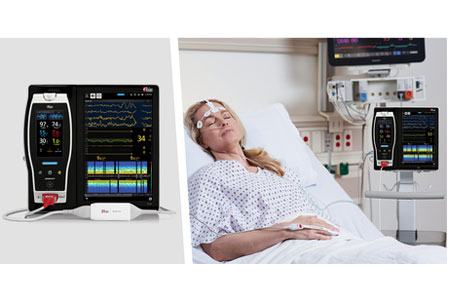Masimo announced the findings of a study published in Frontiers in Neuroscience in which Dr. Lichy Han and colleagues at Stanford University evaluated the ability of Masimo SedLine® brain function monitoring to assess the sedation levels of patients undergoing drug-induced sleep endoscopy (DISE) with dexmedetomidine – a sedative with numerous advantages.
The researchers found that Masimo Patient State Index (PSi), a SedLine parameter derived from electroencephalographic (EEG) data, was statistically significantly associated with dexmedetomidine dosage, and, along with another EEG metric, “better captured changes in brain state from dexmedetomidine and ha[s] potential to improve the monitoring of dexmedetomidine sedation.”1
The researchers noted that while anesthesia induced with dexmedetomidine may more closely resemble natural sleep compared to other sedatives, which makes it particularly appropriate in procedures like DISE, its effects on the brain are inconsistent, which has limited its usage. Better sedation assessment – an improved understanding of its impact and corresponding EEG changes – could help support more widespread adoption of the drug. The researchers accordingly sought to compare and evaluate several methods of assessing sedation in such a scenario. Regarding the choice of EEG markers, they noted that “Previous EEG markers, such as the bispectral index, have been unable to determine differences elicited with dexmedetomidine (Kaskinoro et al., 2011), thus motivating the discovery of novel EEG markers associated with changes in brain state seen with dexmedetomidine sedation.”
They enrolled 51 patients undergoing DISE, for the diagnosis and possible treatment of obstructive sleep apnea, who were sedated with dexmedetomidine and continuously monitored using Masimo SedLine. The concentration of the drug in their bloodstream was determined using a pharmacokinetic model. The concentration levels over time were recorded alongside the values derived from four methods of assessment, two metrics and two analyses: 1) the Richmond Agitation-Sedation Scale (RASS), 2) the SedLine Patient State Index (PSi), 3) spectral edge frequency (SEF95), the frequency below which 95% of total EEG power was contained, and 4) the correlation dimension (CD), a type of fractal dimension used to assess the complexity of a system. To evaluate the efficacy of these methods, the researchers compared them both against dexmedetomidine concentration and against each other.
Comparing the assessment methods to dexmedetomidine concentration, the researchers observed that RASS scores decreased with increasing dexmedetomidine concentration but noted that, “Overall, the RASS score was least able to capture the brain state changes seen with dexmedetomidine, suggesting other metrics for titrating dexmedetomidine sedation may be of greater value.” They found that PSi, SEF95, and CD all decreased statistically significantly with increasing dexmedetomidine concentration (p < 0.001, p = 0.006, and p < 0.001, respectively), “a clear dose-dependent decrease with an inflection point.”
Comparing the methods to each other, they found that PSi, SEF95, and CD all decreased statistically significantly with decreasing RASS score (p < 0.001, p < 0.001, and p = 0.02, respectively), most notably at deeper levels of sedation, suggesting that this is when they may be most beneficial. CD and SEF95 were statistically significantly correlated (p < 0.001, r = 0.515), but there was a subset of points that exhibited high SEF95 but low CD. PSi was most strongly correlated with SEF95 (p < 0.001, r = 0.631).
The researchers concluded, “Complex EEG metrics such as PSi and CD, as compared to RASS score and SEF95, better captured changes in brain state from dexmedetomidine and have potential to improve the monitoring of dexmedetomidine sedation.” In their discussion, they noted that, “CD excelled at reflecting changes seen with rising dexmedetomidine concentration but appeared to exhibit a ceiling effect, whereas PSi had the most significant relationship with the RASS score. Both metrics were able to capture brain state changes corresponding to increased dexmedetomidine dose, showed decreased sensitivity to observer variability and artifact, and corresponded to currently used infusion dosages in pharmacokinetic simulations.”
Study lead authors Lichy Han, MD, PhD and David Drover, MD, Perioperative and Pain Medicine at Stanford University, commented, “This study provides one more step in the journey to understanding SedLine processed EEG parameters that can guide sedation levels. In this case, dexmedetomidine, a widely used sedative, which has not been fully characterized by processed EEG, was titrated using standard indices PSi, SEF95, as well as fractal dimension (CD) commonly applied to time series data like EEG. In contrast to BIS, SedLine parameters (particularly PSi) were able to characterize processed EEG changes that correlated with dexmedetomidine sedation level and concentration, and these parameters correlated better than the subjective measure RASS (the most widely used clinical measure of sedation depth). This work helps clinicians use SedLine as an objective measure reflecting how the brain is responding to this important sedative, dexmedetomidine.”


